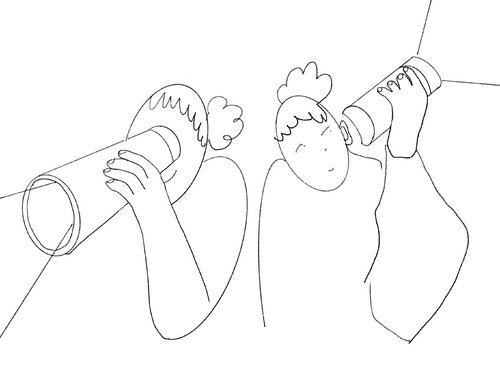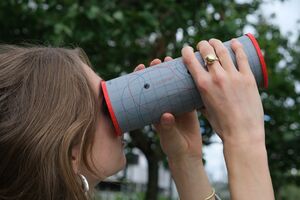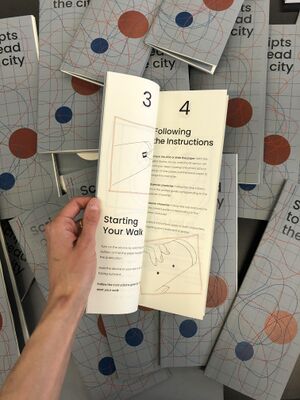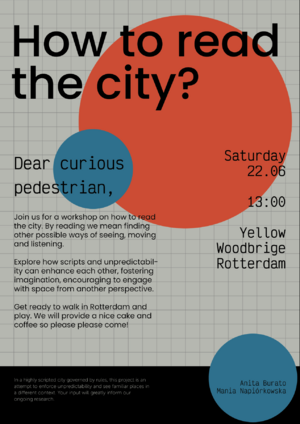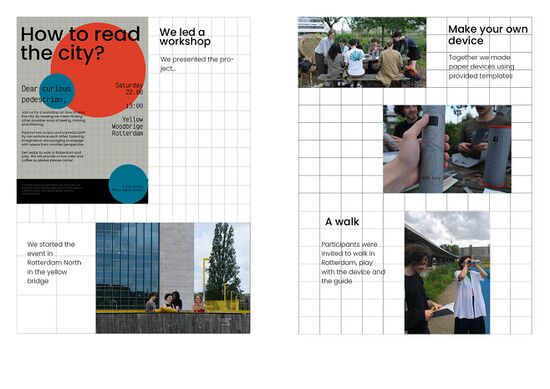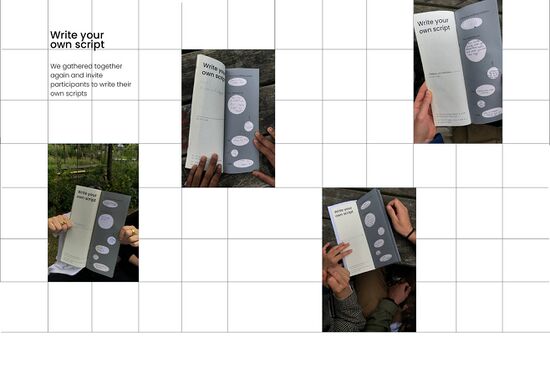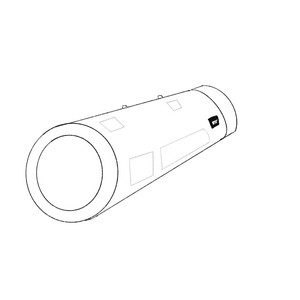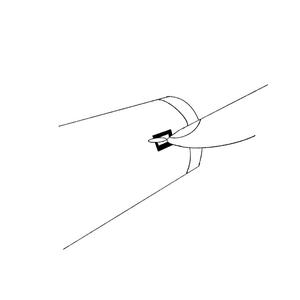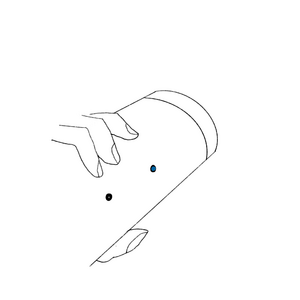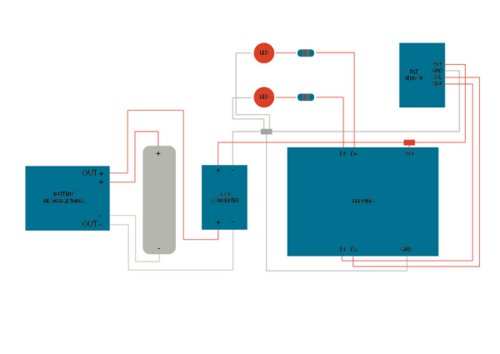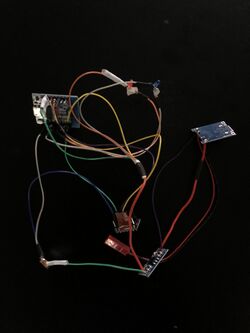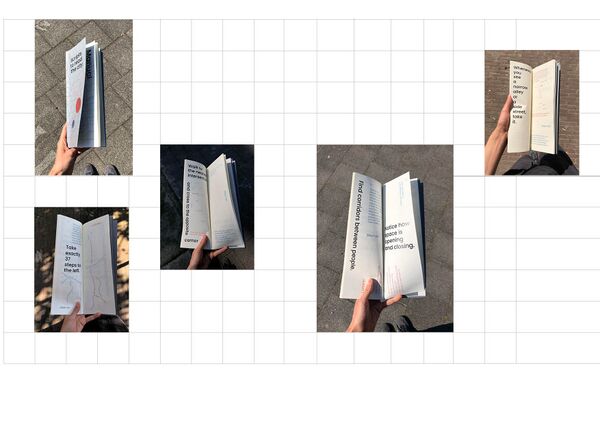Scripts to read the city: Difference between revisions
| (33 intermediate revisions by the same user not shown) | |||
| Line 10: | Line 10: | ||
Scripts to Read the City is an attempt to foster diverse experiences and uses of space, similar to a theater script interpreted differently by each actor. The tools of navigation are a device indicating which character to play and a guide, including a set of directions and instructions. | Scripts to Read the City is an attempt to foster diverse experiences and uses of space, similar to a theater script interpreted differently by each actor. The tools of navigation are a device indicating which character to play and a guide, including a set of directions and instructions. | ||
The project explores a relation between scripts and spontaneity, chance and control, and how scripts and unpredictability can enhance each other, stimulating imagination, encouraging us to engage with space from another perspective. | The project explores a relation between scripts and spontaneity, chance and control, and how scripts and unpredictability can enhance each other, stimulating imagination, encouraging us to engage with space from another perspective. | ||
[[File:Image first cover .png|thumb|center|500x500px]] | |||
== Context == | == Context == | ||
This project is part of the Special Issue 24 - of Experimental Publishing. This past three months were dedicated to explore together the possibilities to compute and publish while being outdoors. During this special issue we were experimenting with loitering as a method to do research in and about the city. | This project is part of the Special Issue 24 - of Experimental Publishing. This past three months were dedicated to explore together the possibilities to compute and publish while being outdoors. During this special issue we were experimenting with loitering as a method to do research in and about the city. There are so many written and unwritten rules, the city is full with order, constantly navigating, prohibiting, forbidding, directing. | ||
There are so many written and unwritten rules, the city is full with order, constantly navigating | |||
If you can realise the rules you can build something that hacks into it, and the first step for this is just paying attention. So we spent the last 3 months walking, listening, observing to create our own set of rules to structure a new experience. Many services and "smart solutions" provide comfort but also drastically reduce the level of unpredictability in a city. In a highly scripted cities, filled with prohibitions, navigations, we asked ourselves, how can we use scripts to enforce and strenghten unpredictability. | If you can realise the rules you can build something that hacks into it, and the first step for this is just paying attention. So we spent the last 3 months walking, listening, observing to create our own set of rules to structure a new experience. Many services and "smart solutions" provide comfort but also drastically reduce the level of unpredictability in a city. In a highly scripted cities, filled with prohibitions, navigations, we asked ourselves, how can we use scripts to enforce and strenghten unpredictability. | ||
| Line 35: | Line 36: | ||
==Workshop== | ==Workshop== | ||
[[File:Posterworkshopscripts.png|thumb|left]] | [[File:Posterworkshopscripts.png|thumb|left|poster]] | ||
[[File:Documnetation4.jpg|thumb|550x550px|center]] | |||
1. presentation of the project | |||
2.play with the device | |||
3. Make your own device | |||
4. Walk - 30 minutes | |||
5. Write scripts | |||
6. Feedback | |||
[[File:Documnetation5.jpg|thumb|center|550x550px]] | |||
== Prototyping the device == | |||
[[File:Parts-manual .png|thumb]] | |||
[[File:Turnon-mannual.png|thumb]] | |||
[[File:Indicating-character.png|thumb]] | |||
<blockquote> | |||
=== '''Parts:''' === | |||
1. Subjective lens | |||
2. Tilt sensor | |||
3. LEDs | |||
4. Power supply | |||
5. Microcontroller | |||
6. Voltage stabilizer | |||
7. On off switch | |||
=== Starting your walk: === | |||
Turn on the device by switching the power | |||
button. | |||
Hold the device to your eye or ear, with the lens | |||
facing outward. | |||
Follow the instructions given by the device and | |||
start your walk | |||
=== Following the instructions === | |||
• Check the LEDs: With the | |||
digital device, as you walk the tilt sensor will | |||
count your steps causing one of two LEDs to | |||
light up. | |||
• Observer character: Follow the blue instruc- | |||
tions in the printed guide corresponding to the | |||
Observer character | |||
• Listener character: Follow the red instructions | |||
in the printed guide corresponding to the | |||
Listener character</blockquote> | |||
=== Wiring sketch === | |||
[[File:Wiringsketch.png|thumb|left|500x500px|wiring sketch]] | [[File:Wiringsketch.png|thumb|left|500x500px|wiring sketch]] | ||
[[File:Unnamed-3.jpg|thumb|center]] | [[File:Unnamed-3.jpg|thumb|center|333x333px]] | ||
Final Code: | |||
=== Final Code: === | |||
include <BMI160Gen.h> | include <BMI160Gen.h> | ||
| Line 109: | Line 178: | ||
} | } | ||
==Scripts== | |||
[[File:Documnetation3.jpg|thumb|600x600px]] | |||
The scripts are open to interpretation, feel free to perform them in the way you prefer. | |||
Shift the order, play by switching between pages or just follow one instruction on repeat. | |||
Every instruction has a number assigned to it, what would happen if you try to change their order? | |||
'''page 1'''<blockquote> | |||
N: Walk along one street. | |||
</blockquote> | |||
<br /> | |||
O: Read the words that you can find written around you. Write a poem with the sounds they make. | |||
<br /> | |||
L: Listen for the layers of sound. Notice the background hum, the mid-level sounds, the prominent noises and walk along them. | |||
Now perform the sounds as if you were a musician, using the device as your instrument.<br /> | |||
'''page 2'''<blockquote> | |||
N: Whenever you see a narrow alley or a side street, take it. | |||
</blockquote> | |||
O: Focus on the textures you encounter—brick walls, building's façade, the color of a passerby's coat, wooden benches, metal railings. Touch and describe them | |||
<br /> | |||
L: Listen to the rhythm the sounds around you are creating. Try to ignore the tones, and only focus on the pattern the sounds are making. Some are fast, slow, repetitive. How many different kinds of rhythms can you collect?<br /> | |||
'''page 3'''<blockquote>N: Walk to the quietest place you can think of in your close surroundings</blockquote> | |||
<br /> | |||
O: Search for written and unwritten scripts. How are you expected to behave even in this tucked away place? Are they prohibitions or encouragements? | |||
<br /> | |||
L: Now listen to the loudest sound | |||
'''page 4'''<blockquote> | |||
N: Walk to the nearest intersection and cross to the opposite corner | |||
</blockquote> | |||
O: Spend some time looking up at the tops of buildings Then carefully examine the ground Look for objects that could easily stay unnoticed Spend a moment scanning the building from top to the bottom - observing without moving. | |||
<br />L: Identify as many sounds as you can. What do they tell you about this place? | |||
'''page 5'''<blockquote>N: Take a left at the intersection and follow the road</blockquote> | |||
O: Imagine you were able to archive exactly how your eyes are moving | |||
L: Close your eyes and listen to the city’s sounds for a moment They may appear as one big thing at first, but as you pay more attention, you notice how each is so separate. | |||
Imagine now that they are different instruments in a song, and try to find all of them. | |||
'''page 6'''<blockquote>N: Cross the street and walk diagonally until you reach a grassy area</blockquote> | |||
O: Look at how the buildings and objects around you touch. Are they kind to each other? Are their bonds strong? How long do you imagine they could have they been there for together? | |||
L: Walk along the perimeter of the grassy area, stop at various points and listen how different the reoccuouring sounds are in each of these spots. Read them and compare how they sound from place to place. | |||
'''page 7'''<blockquote>N: Pick one moving sound you think you can follow and see where it brings you</blockquote> | |||
<br />O: Stand still, in front of a city object of choice. Examine it closely. Notice how it looks, feels and sounds. How it exists in space. Now imagine being this object, looking at the world from the same stationary position. Pretend you share the same set of eyes and go for a little adventure. | |||
<br /> | |||
L: Read for sounds like the one you followed. Are they frequent? Loud? What do they tell you about this place? And how are they connected to it? | |||
'''page 8'''<blockquote> | |||
N: Take exactly 37 steps to the left. Be conscious of your movement step-by-step, as if you were performing an elaborate dance. Feel every muscle moving, each millimeter creating its own choreography | |||
</blockquote> | |||
O: Notice how moving in a different way makes you look at things. Can you focus on looking if you move in a way that feels unnatural to you? | |||
L: Focus on the sounds your careful movements produce, do your steps rumble?<br /> | |||
'''page 9'''<blockquote>N: Look at the people in the environment around you. Pick one and copy how they move. Their step, how they move their hands, maybe even their tone of voice if you can hear them talking.</blockquote> | |||
O: Can you see a surveillance camera? | |||
L:How much noise are you making right now? How loud is your step? Are you listening to music on headphones? Are they bleeding any sound? Are you breathing loudly enough to be heard? | |||
page 10 | |||
'''page 10'''<blockquote>N: Walk until you find a bench. Sit down and go to the page number...</blockquote> | |||
O: Observe the people around you | |||
Notice their body language, expressions, and interactions. What stories do you imagine for them? Imagine who they are, and what they notice in the city. Look for this. | |||
L: Read around and search if someone else is repeating them. Are they the same? | |||
Latest revision as of 15:03, 27 June 2024
By reading we mean finding another possible form of seeing, moving, listening
The project imagines an urban environment that can be read, analyzed and criticized as a text. By reading the city in this way we find other possible ways of seeing, moving and listening. In a scripted city, marked by escalating levels of perfection, efficiency and control, the emancipatory aspects of urban life are undermined, allowing little room for anything that doesn't fit the image of the "norm".
Scripts to Read the City is an attempt to foster diverse experiences and uses of space, similar to a theater script interpreted differently by each actor. The tools of navigation are a device indicating which character to play and a guide, including a set of directions and instructions.
The project explores a relation between scripts and spontaneity, chance and control, and how scripts and unpredictability can enhance each other, stimulating imagination, encouraging us to engage with space from another perspective.
Context
This project is part of the Special Issue 24 - of Experimental Publishing. This past three months were dedicated to explore together the possibilities to compute and publish while being outdoors. During this special issue we were experimenting with loitering as a method to do research in and about the city. There are so many written and unwritten rules, the city is full with order, constantly navigating, prohibiting, forbidding, directing.
If you can realise the rules you can build something that hacks into it, and the first step for this is just paying attention. So we spent the last 3 months walking, listening, observing to create our own set of rules to structure a new experience. Many services and "smart solutions" provide comfort but also drastically reduce the level of unpredictability in a city. In a highly scripted cities, filled with prohibitions, navigations, we asked ourselves, how can we use scripts to enforce and strenghten unpredictability.
- The tools of navigation for this project, to help us question how we see, move and listen within the scripted city, are:
- 1) a device, a monocular with a built in tilt sensor, that based on step count assign a character to follow 2) step by step printed guide, based on the indicated character, it provides a user with a set of directions and instructions.
The device together with a printed "step by step guide" explore a relation between scripts and spontaneity, chance and control, and how scripts and unpredictability can enhance each other, fostering imagination, encouraging us to engage with space from another perspective.
Workshop
1. presentation of the project
2.play with the device
3. Make your own device
4. Walk - 30 minutes
5. Write scripts
6. Feedback
Prototyping the device
Parts:
1. Subjective lens
2. Tilt sensor
3. LEDs
4. Power supply
5. Microcontroller
6. Voltage stabilizer
7. On off switch
Starting your walk:
Turn on the device by switching the power
button.
Hold the device to your eye or ear, with the lensfacing outward.
Follow the instructions given by the device andstart your walk
Following the instructions
• Check the LEDs: With the
digital device, as you walk the tilt sensor will
count your steps causing one of two LEDs to
light up.
• Observer character: Follow the blue instruc-tions in the printed guide corresponding to the
Observer character
• Listener character: Follow the red instructionsin the printed guide corresponding to the
Listener character
Wiring sketch
Final Code:
include <BMI160Gen.h>
define listener 12
define observer 14
const int select_pin = 10; const int i2c_addr = 0x69; int aState; int aLastState;
void setup() {
Serial.begin(115200); while (!Serial); BMI160.begin(BMI160GenClass::I2C_MODE, i2c_addr); BMI160.setStepCountEnabled(1); BMI160.setStepDetectionMode(0); pinMode (listener, OUTPUT); pinMode (observer, OUTPUT); digitalWrite(listener, HIGH); delay (1000); digitalWrite(listener, LOW);
}
void loop() {
int steps = BMI160.getStepCount();
if (steps > 100){
BMI160.resetStepCount();
}
Serial.println(steps);
aState = digitalRead(steps);
Serial.println(steps);
if(steps > 0 && steps < 50){
digitalWrite (listener, HIGH);
}
else {
digitalWrite (listener, LOW);
}
if(steps > 50 && steps < 100){
digitalWrite (observer, HIGH);
}
else {
digitalWrite (observer, LOW);
}
}
Scripts
The scripts are open to interpretation, feel free to perform them in the way you prefer.
Shift the order, play by switching between pages or just follow one instruction on repeat.
Every instruction has a number assigned to it, what would happen if you try to change their order?
N: Walk along one street.
O: Read the words that you can find written around you. Write a poem with the sounds they make.
L: Listen for the layers of sound. Notice the background hum, the mid-level sounds, the prominent noises and walk along them.
Now perform the sounds as if you were a musician, using the device as your instrument.
N: Whenever you see a narrow alley or a side street, take it.
O: Focus on the textures you encounter—brick walls, building's façade, the color of a passerby's coat, wooden benches, metal railings. Touch and describe them
page 3
L: Listen to the rhythm the sounds around you are creating. Try to ignore the tones, and only focus on the pattern the sounds are making. Some are fast, slow, repetitive. How many different kinds of rhythms can you collect?
N: Walk to the quietest place you can think of in your close surroundings
O: Search for written and unwritten scripts. How are you expected to behave even in this tucked away place? Are they prohibitions or encouragements?
L: Now listen to the loudest sound
N: Walk to the nearest intersection and cross to the opposite corner
O: Spend some time looking up at the tops of buildings Then carefully examine the ground Look for objects that could easily stay unnoticed Spend a moment scanning the building from top to the bottom - observing without moving.
L: Identify as many sounds as you can. What do they tell you about this place?
N: Take a left at the intersection and follow the road
O: Imagine you were able to archive exactly how your eyes are moving
L: Close your eyes and listen to the city’s sounds for a moment They may appear as one big thing at first, but as you pay more attention, you notice how each is so separate.
Imagine now that they are different instruments in a song, and try to find all of them.
N: Cross the street and walk diagonally until you reach a grassy area
O: Look at how the buildings and objects around you touch. Are they kind to each other? Are their bonds strong? How long do you imagine they could have they been there for together?
L: Walk along the perimeter of the grassy area, stop at various points and listen how different the reoccuouring sounds are in each of these spots. Read them and compare how they sound from place to place.page 7
N: Pick one moving sound you think you can follow and see where it brings you
O: Stand still, in front of a city object of choice. Examine it closely. Notice how it looks, feels and sounds. How it exists in space. Now imagine being this object, looking at the world from the same stationary position. Pretend you share the same set of eyes and go for a little adventure.
L: Read for sounds like the one you followed. Are they frequent? Loud? What do they tell you about this place? And how are they connected to it?
N: Take exactly 37 steps to the left. Be conscious of your movement step-by-step, as if you were performing an elaborate dance. Feel every muscle moving, each millimeter creating its own choreography
O: Notice how moving in a different way makes you look at things. Can you focus on looking if you move in a way that feels unnatural to you?
L: Focus on the sounds your careful movements produce, do your steps rumble?
N: Look at the people in the environment around you. Pick one and copy how they move. Their step, how they move their hands, maybe even their tone of voice if you can hear them talking.
O: Can you see a surveillance camera?
L:How much noise are you making right now? How loud is your step? Are you listening to music on headphones? Are they bleeding any sound? Are you breathing loudly enough to be heard? page 10
N: Walk until you find a bench. Sit down and go to the page number...
O: Observe the people around you
Notice their body language, expressions, and interactions. What stories do you imagine for them? Imagine who they are, and what they notice in the city. Look for this.
L: Read around and search if someone else is repeating them. Are they the same?

